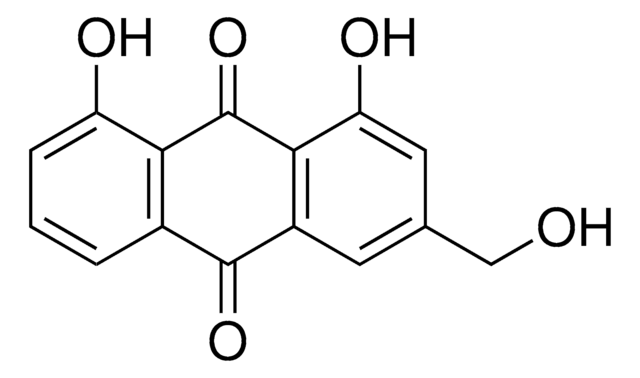56690
Hypericin from Hypericum perforatum
~95% (HPLC)
Synonym(s):
4,5,7,4′,5′,7′-Hexahydroxy-2,2′-dimethylnaphthodianthrone, Cyclo werrol, Hypericum red
About This Item
Recommended Products
Assay
~95% (HPLC)
solubility
1 M NaOH: 10 mg/mL, turbid, dark green
SMILES string
Cc1cc(O)c2C(=O)c3c(O)cc(O)c4c5c(O)cc(O)c6C(=O)c7c(O)cc(C)c8c1c2c(c34)c(c78)c56
InChI
1S/C30H16O8/c1-7-3-9(31)19-23-15(7)16-8(2)4-10(32)20-24(16)28-26-18(12(34)6-14(36)22(26)30(20)38)17-11(33)5-13(35)21(29(19)37)25(17)27(23)28/h3-6,31-36H,1-2H3
InChI key
BTXNYTINYBABQR-UHFFFAOYSA-N
Looking for similar products? Visit Product Comparison Guide
General description
Application
- in the broth macrodilution test and antibacterial assay against bacterial strains
- as a medium supplement for human malignant melanoma cells for irradiation and localization studies
- as a ligand for pregnane X receptor (PXR) and as defatting medium supplement for primary human hepatocytes culture
Biochem/physiol Actions
Packaging
Signal Word
Warning
Hazard Statements
Precautionary Statements
Hazard Classifications
Acute Tox. 4 Oral
Storage Class Code
11 - Combustible Solids
WGK
WGK 3
Flash Point(F)
Not applicable
Flash Point(C)
Not applicable
Personal Protective Equipment
Regulatory Listings
Regulatory Listings are mainly provided for chemical products. Only limited information can be provided here for non-chemical products. No entry means none of the components are listed. It is the user’s obligation to ensure the safe and legal use of the product.
JAN Code
56690-1MG-BULK:
56690-BULK:
56690-VAR:
56690-1MG:
Certificates of Analysis (COA)
Search for Certificates of Analysis (COA) by entering the products Lot/Batch Number. Lot and Batch Numbers can be found on a product’s label following the words ‘Lot’ or ‘Batch’.
Already Own This Product?
Find documentation for the products that you have recently purchased in the Document Library.
Customers Also Viewed
Our team of scientists has experience in all areas of research including Life Science, Material Science, Chemical Synthesis, Chromatography, Analytical and many others.
Contact Technical Service









